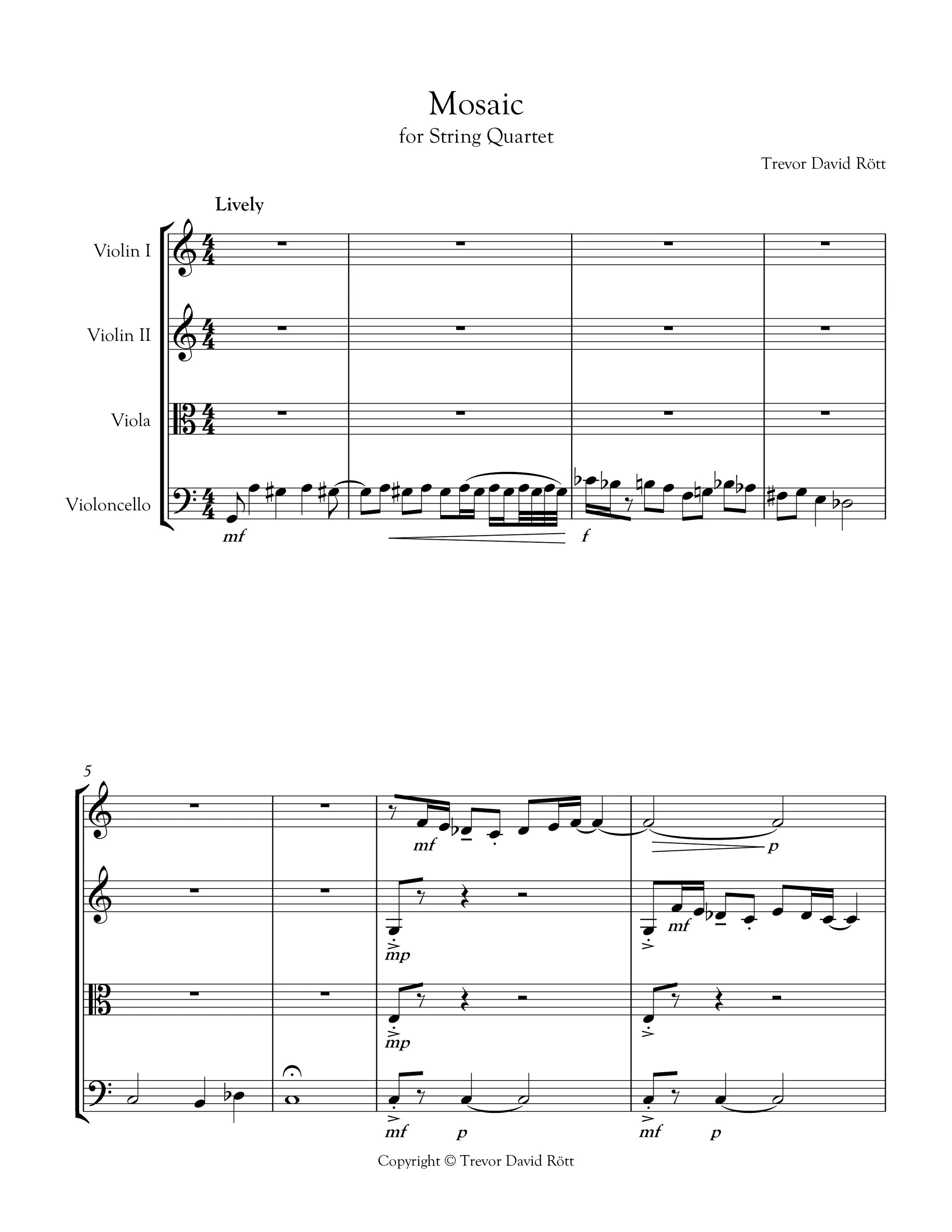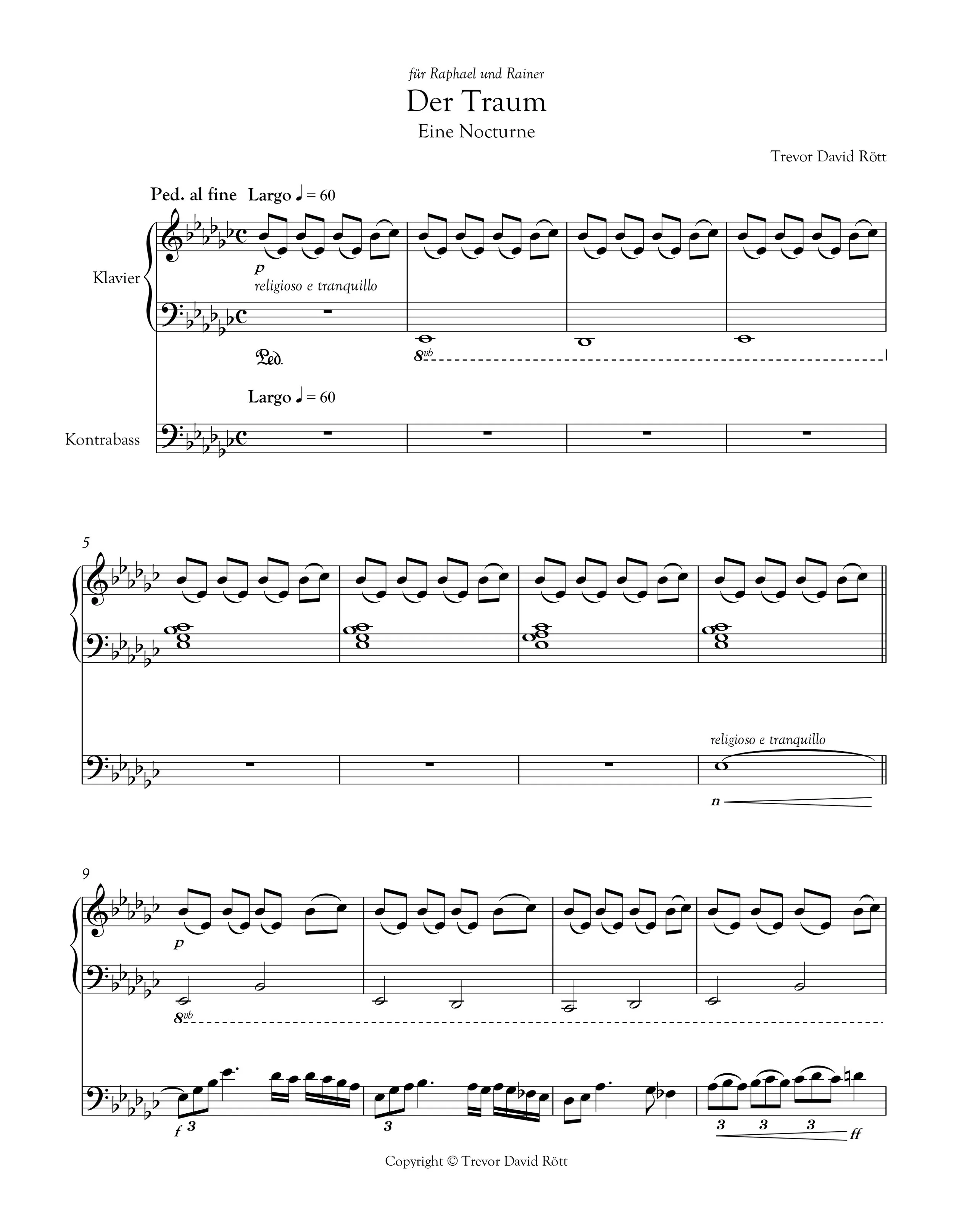Composition
For commissioning, licensing, or further information, please visit the Contact page via the link below.
In recordings where the performers are not stated, either session musicians or sampled sounds were employed.
Divine Liturgy
Liturgy of St John Chrysostom, Upcoming
The Divine Liturgy of St John Chrysostom is the primary eucharistic service of the Orthodox Church. In his setting of this ancient set of text, Rött is composing a liturgy that resonates with the Orthodox Christians of the New World. This is accomplished through the use of musical elements drawn from the cultures of the most populous traditionally Orthodox ethnic groups. The texture is choral and in a Slavic style, following in the tradition of Romantic Period Russian composers of liturgical music such as Rachmaninoff, Chesnokov, and Gretchaninoff. The melodic material and extrapolation of harmonies is drawn from the Byzantine Psaltic Art with melodic developments also leaning on Arabic patterns of modal development. These elements are employed with an even hand so as to appeal to a truly pan-Orthodox sensibility. The languages employed are, likewise, English, Greek, Church Slavonic, and Arabic. Composing for mainly for American listeners, English is used liberally and throughout for the sake of clarity of text: the greatest concern for the setting of a liturgy. The other languages employed reflect the liturgical languages of the majority of ecclesiastical jurisdictions within the New World. Their nuanced application is to connect listeners to the traditions of their churches, and bring to mind the legacy of their families and communities. Every element of this liturgy is carefully considered to draw listeners together within their communities, and — together — towards the chalice.
La La La
Piece for Open Instrumentation, 2023
La La La is an eclectic and accessible piece that was written in lead sheet style without specific instrumentation. The sole departure from the lead sheet model is the inclusion of the primary rhythmic pattern for each section. The only three prescriptions, then, are melody, rhythm, and harmony. The melodic material draws heavily from Arabic maqam practice, both in contour and development. The rhythmic material is likewise drawn from the same source. The harmonies follow from the the pitch material of the melody extrapolated out to extended tertian modal harmony. The nonprescriptive nature of the score invites improvisation and open interpretation on the part of the performer. The piece is equally at home with a new music ensemble as it is with a jazz group; any genre of instrumentation is suitable and — indeed — worth exploring. The music itself is both intellectually appealing and inviting to play.
Dear Marie
Rock Album, 2022
Dear Marie is an album under the joint authorship of Trevor David Rött and performing artist Alexander Michael Voss. Voss is the lyricist and was the première performer of the album; Rött is the composer and was the producer (see Audio Engineering page). While fundamentally a popular album, the aim in composition was to infuse the music with an atmosphere of classical balance and romantic pathos. The result is an emotionally-charged, glamourous set of songs with an unconventional texture and broad appeal.
Performing Artist Link
Piece for Viola
Piece for Viola, 2021
Rött’s 2021 Piece for Viola is an exploration of the timbre and capabilities of the instrument. The piece explores the various articulation styles of the viola while contrasting these articulations against frequent moments of silence. Pensive and meditative, yet energetic in its own right; the piece is transfixing to the listener and technically rewarding to the nuanced performer.
Music for Stereophonic Field
Electronic Piece, 2020
Rött’s 2020 composition Music for Stereophonic Field It also represents an early foray into principles of sound design within the context of a highly developed formal structure. The music explores the space around the listener as the various tracks play with panning and move through shifting audio filters; something of a textural and spatial counterpoint. The composition is also layered with culturally relevant secrets that will appeal to those with backgrounds in musicology, philosophy, literature, or audio engineering.
The Iridescent Mind
Sound Mass for Organ Ensemble, 2020
The Iridescent Mind is Rött’s 2020 sound mass composition intended to wash over the listener with an immersive experience. The instrumentation is deliberately vague and consists of an organ part, two other keyboard instrument parts, an optional percussion part (preferably bass drum), and four parts that broadly correspond to soprano, alto, tenor, and bass roles. Other than the keyboard parts, any number of performers on any collection of instruments is suitable at the direction of the conductor. The piece is intended to be performed in an organ hall with the instrumentalists arranged around the space. No melodies are given to the performers and aleatoric improvisation within the confines of a predetermined sonorous schema. The pitch material of the piece utilizes a repeating tetrachordal lattice that creates a harmonically kaleidoscopic effect. This, combine with the aleatoric nature of the performance, the placement of the performers, and formal structure, creates a sonic experience which overwhelms and spellbinds the listener.
There Pieces for Piano
Three Pieces for Piano, 2020
Rött’s Three Pieces for Piano is a short collection of piano works composed utilizing a twelve-tone matrix. In the absence of tonality, Rött explores the relationships of the series ageist itself in various transformations. The pieces are brief and place an emphasis on the timbre of the instrument and the texture of the music.
Anthropology
Symphonic Poem, 2020
Rött’s 2020 symphonic poem Anthropology is a tour de force of his formal education in composition at Syracuse University. Scored for large orchestra, Anthropology uses a three-theme sonata structure that goes to great lengths to explore modal implications, rhythmic relationships, and tetrachordal melodic development. This is presented within a largely neo-romantic style. Equal parts appealing, impassioned, and transcendental, Anthropology lives up to its name.
Audio File Coming Soon
Mosaic
Piece for String Quartet, 2019
The melodic and rhythmic material of Rött’s 2019 Mosaic was inspired Middle Eastern music. The pitch content and progression of the melodies reference the Arabic maqam modal system. The rhythms lean on Arabic rhythmic modes, namely those found in contemporary Levantine dabka and popular music. The overall form is built from recurring melodic fragments arranged in something of a mosaic.
Adagio
Duet for Flute and Oboe, 2019
Rött’s 2019 Adagio duet for flute an oboe is a charming, short piece that beautifully pairs the two instruments while playing to their timbral strengths. The range and colour of both instruments are explored with a nuances setting of line that creates idiomatic, florid music.
From Silence
Chamber Concerto for Viola, 2019
Following a brief exposition of harmonic priorities, Rött’s 2019 From Silence features an expressive melody soaring though glittering harmonies. The melody lyrically wander’s through harmonic and rhythmic textures before finally finding its way back home. From Silence explores a multi-octave tetrachordal system that is tonal on the micro-scale and symmetrical on the macro-scale. In this piece, the application of pedal tones and mindful melodic construction aids in maintaining pitch-centricity.
Through Darkness
Piece for Chamber Ensemble, 2018
Rött’s 2019 Through Darkness was composed through direct collaboration with the Syracuse University Contemporary Music Ensemble. The piece grew very organically during this process. Through Darkness incorporates textures of the minimalist genre along with striking rhythmic material reminiscent classic rock. Overlaying this are contrapuntal melodies derived from Byzantine tonality.
Gin & Octatonic
Piece for Saxophone Quartet, 2018
Gin & Octatonic for saxophone quartet explores the interplay of each iteration of Rimsky-Korsakov’s octatonic scale between voices. Each voice only employs eight pitch classes but they come together to form a cohesive whole. The second movement realizes an additive rhythm process with a syncopated ostinato. This process that defines the length of the movement.
The Kraken
Song, 2018
This 2018 piece is a setting of Alfred, Lord Tennyson’s 1830 sonnet ‘The Kraken’ as an art song.
Below the thunders of the upper deep,
Far, far beneath in the abysmal sea,
His ancient, dreamless, uninvaded sleep
The Kraken sleepeth: faintest sunlights flee
About his shadowy sides; above him swell
Huge sponges of millennial growth and height;
And far away into the sickly light,
From many a wondrous grot and secret cell
Unnumbered and enormous polypi
Winnow with giant arms the slumbering green.
There hath he lain for ages, and will lie
Battening upon huge sea worms in his sleep,
Until the latter fire shall heat the deep;
Then once by man and angels to be seen,
In roaring he shall rise and on the surface die.
Twelve Breaths
Piece for Open Instrumentation, 2017
Tranquil and prayerful, Twelve Breaths is a two-voice piece that meditates on melodic contours related to a Byzantine hard chromatic genus. As named, the piece is composed of twelve phrases, breaths, and explores factors of that number. The melodic content is divided into three groups of four where the final group repeats the first. The bass divides the piece into four groups of three based on scale degree. The way in which these divisions play against each other, along with the serenity of the modal content, create a peaceful and fulfilling final cadence. The piece may be played with any melodic instrument and any bass instrument.
Warlock
Piece for Vibraphone, 2017
Piece for Vibraphone and Piano, 2017
Piece for Piano, 2017
Warlock explores a tetrachordal lattice extended over several octaves restructured into a semblance of harmonic functionality. The melody of Warlock is algorithmically built from the Fibonacci Sequence.
Der Traum
Nocturne for Piano and Contrabass, 2017
Rött’s 2017 nocturne, Der Traum, is resplendent with lyrism and emotion. True to its name, Der Traum affects a dreamlike texture and captivates the listener with its beautiful melodies and trancelike ostinato.






